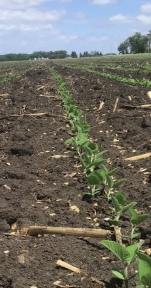Westfield, Indiana, USA
March 18, 2024
“Data has shown that planting soybeans early so they have the opportunity to maximize the growing season pays,” says AgriGold Agronomist Ron Roling. “Even the insurance companies have seen the advantage and moved up their planting windows.”
At grower meetings, Roling often asks who has started planting soybeans earlier and who regrets it. “Nobody really regrets it,” he says. That speaks volumes.
Roling expects the trend of planting soybeans before corn to continue. And after a mild winter, more Iowa farmers than ever are considering early soybean planting. There are several strategies farmers can use to mitigate the risks and unlock the full potential of their acres.
Protect with a quality seed treatment
Early planting can heighten the risk of disease, whether that’s seedling disease or sudden death syndrome (SDS). Roling says the No. 1 thing farmers planting soybeans early should do is make sure they are using standard rates of a high-quality seed treatment.
“Fully treat your soybean seed with products that have fungicide and insecticide protection, as well as something for SDS protection, like Saltro®,” he advises. “Think of that seed treatment like an insurance policy.”
Don’t try to “compensate” with high planting populations
Farmers planting soybeans early should also consider dialing back their planting populations, Roling says. “If farmers use a fully loaded seed treatment system and start with bigger, healthier plants that are spaced out and able to capture more sunlight and benefit from more air movement, they’ll set the stage for plants to load on the pods and also create a less favorable environment for disease.”
Many farmers assume early planting comes with more loss due to damping off or crusting or other soil situations, but Roling says that assumption isn’t backed by germination data. In fact, AgriGold’s trials in recent years on seeding rates and planting times have shown fields planted earlier at lower populations have the most favorable results.
That’s a major shift in ideology. “When I started in the industry in the late ’90s, we were drilling soybeans at 200,000 seeds per acre or more,” Roling points out. “Today, farmers are setting world-record soybean yields of more than 200 bushels an acre with a seeding rate of 85,000 or less.”
The general rule of thumb, according to Roling, is the more productive the ground, the lower a farmer can go with his or her seeding population.

Residue can make it difficult for an early planted soybean crop to get off to a strong start, as demonstrated by the emergence differences showcased here.
Manage residue and focus on a good seedbed
Residue management is another must for some areas. Residue in the row can make it difficult to get a level seedbed for uniform planting, plus it can complicate emergence. “Anything a farmer can do to get the residue off the row is critical to achieving uniform planting and even stands,” Roling says.
Residue can also suppress soil temperatures. “Soil thermometers have shown there can be a 6- to 10-degree difference in soil temperature where residue is,” he points out. “Clearing the residue from the row allows the soil to warm much quicker, encouraging better germination.”
Roling encourages farmers to pay attention to emergence scores but not get hung up on them. “Choose a later maturity soybean variety that’s a good fit for your field and management style so you can take full advantage of the extended growing season,” he advises.

An early planted soybean field planted into proper conditions can deliver big yields.
Be ready to go when soils are fit
Every year, it seems like conditions turn fit for planting quickly. That’s why it’s important farmers have their equipment ready, their supplies in place, their seed treatments on and anything else they can do to prepare.
Roling cautions against forcing soybeans in before a field is ready and says farmers should plant in the order fields turn fit. “Fields with lighter soil types will likely be ready first,” he says. “For heavier ground, those that are tiled best or have good drainage are likely to be fit first.”
Soybeans are a hardier plant, and Roling says it’s not uncommon for soybeans to be planted 6 to 10 days or more before corn. “Ideally, there will be a window when soil conditions are ideal and the forecast is trending warmer,” he says.
“Your wins are our wins,” he continues. “We make a point of knowing what works and what doesn’t when it comes to early soybean planting because we want farmers to get the most from every acre.”
ABOUT AGRIGOLD
AgriGold offers high-performing hybrids paired with the latest agronomic knowledge and data to achieve exceptional crop performance, year after year. Based in Westfield, Indiana, AgriGold is for the farmer who wants a true seed partner that is an ally in the field. For more information, visit AgriGold.com and follow us on Facebook, Instagram, LinkedIn and X, formerly known as Twitter.
ABOUT AGRELIANT GENETICS
AgReliant Genetics is committed to providing trusted seed solutions that help farmers grow. We do this by focusing solely on seed and delivering one-of-a-kind, high-performing hybrids. Founded in 2000 by global seed companies KWS and Limagrain, AgReliant Genetics benefits from direct access to a global corn germplasm pool and has a top four corn research program. Through our seed brands — AgriGold® and LG Seeds in the U.S. and PRIDE® Seeds in Canada — we proudly offer the latest innovation to our farmer customers, whether they grow corn, soybeans, sorghum or alfalfa. Discover more at AgReliantGenetics.com.